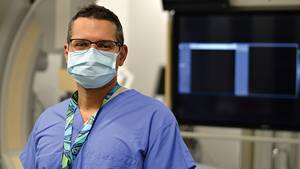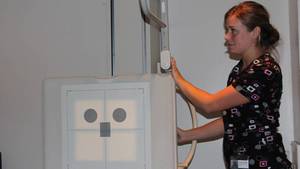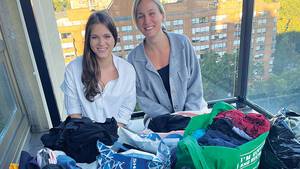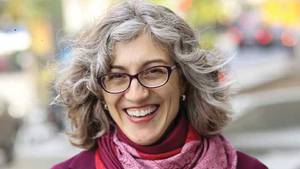A supply of anti-seizure medication has been lost by a patient, the electrodes for tomorrow’s surgery haven’t arrived, her desk is littered with paperwork, and she couldn’t tell what or when she ate last, yet Susan Rahey will tell you she has the best job in the world.
“…days like today are…crazy,” she says, with a few omitted expletives, “but I get to make a difference.”
And that’s the attitude Rahey’s carried since she began working with epilepsy patients 21 years ago - an attitude that has helped hundreds of patients live seizure-free.
Rahey’s trademark look is a white lab coat ordained with a collection of pins in tribute to Canadian war veterans (she’s a WW1 history buff), a “no seizures” button that was once mistaken for a “no seniors button,” and a “keep calm and carry on” pin (she says it’s a joke because she’s never calm).
Susan is the QEII Health Sciences Centre’s Neurophysiology Program Coordinator, working in the Epilepsy Clinic with Dr. Mark Sadler. That means she is often the first person epilepsy patients from Atlantic Canada meet in the outpatient clinic when previous treatment has been unsuccessful.
“Many of these patients have already been to at least one neurologist, and have been living with seizures for years. They come in feeling like no one cares about them, no one understands them. I get to say ‘we can help you, give us a chance,’ and usually, we can help them,” she says. “It’s my job to make them trust us and I think I’m pretty good at it.”
“Susan’s able to develop a relationship,” explains Dr. Sadler, adding that Rahey cares for the individual, not only their condition. “She sees the problems they have dealing with chronic diseases, with their finances, their jobs, their families, etc. and works closely with them. She is committed to making their lives better.”
Liam’s story is an example of the care Rahey provides.
Liam* was 17 when Rahey met him. He had been experiencing seizures for two years and had tried several medications with no success. Surgery was his only chance of living a seizure-free life, so he scheduled an operating room date. Then, a few days before, when he was already at the QEII, he began to panic.
“He was terrified and thinking that the seizures were something he could live with,” explains his mother, Linda.
Dr. Sadler, worried Liam might make a decision he would later regret, called Susan for help.
“It was Saturday morning and I was out doing my usual second-hand clothing thing,” Rahey recalls. “I got in my car and headed to the QEII’s Halifax Infirmary to chat with him. He was scared -- and it is scary to think you‘re going to have your skull opened. We talked about what life could be like with the surgery and what it definitely would be like without it. I gave him my home phone number and told him to call me if he wanted to talk more.”
The next day, while she was enjoying Easter dinner, the phone rang.
“It was Liam saying he was having the surgery. It was a wonderful, wonderful thing.”
Liam is now completely seizure free. He emails Rahey regularly, takes her out for the occasional drive - something he always wanted to do but couldn’t for years because of his epilepsy - and to lunch, either for a burger at MacDonald’s or Greek food at the Athens Restaurant.
“This is why I have the most amazing job. Many of my stories are like this.”
Although Rahey can't imagine a more fulfilling job, it wasn‘t the career she envisioned when she left Cape Breton to attend Dalhousie University.
“I was going to spend my life on the ocean as a fishery biologist. That was my dream.”
To pay her tuition, she spent her summers working as a ward clerk at the Victoria General. During the same time, her relationship with her boyfriend (now husband) was becoming more serious and the thought of spending months at sea was losing its appeal. After she graduated, she was offered a job at the Electroencephalography (EEG) lab, measuring the electrical activity in patients’ brains. She knew nothing about epilepsy. “I didn’t even know what the lab did.”
She didn’t know it, but she was embarking on a career in the then uncharted field of a neurophysiology technologist. There was no formalized training, and she learned on the go, with the support and encouragement of her late ‘boss’, Dr. H.N.A. Macdonald. Soon she was playing an active role in creating professional standards. She has served as president on national boards and has travelled all over the world -- from Cuba to Saudi Arabia -- to teach her colleagues.
She also met her first patients, with many of whom she would form decade-long bonds.
“I met one girl when she was 16. She’s now 35 and we‘re still in contact. I’m always getting emails, letters and baby pictures from our patients. One patient calls me her Halifax Mom. I love being a mom, and this job is an extension of that role to an even larger family.”
Although Rahey knows her passion and devotion to her patients has helped many live a better quality of life, she notes her role can be emotionally difficult.
“There was one young guy who I was always getting mad at for not taking his medication -- I used to make him come visit me because it was the only way to make sure that he got his medication. Then he got better and we lost touch. The next I heard, he was dead,” she recalls, tears filling her eyes. “He had a convulsion and died in his sleep. Now that broke my heart.”
“His mom later wrote a story about it and in it she said, ‘Susan treated him like a son.’ Sometimes I wish I didn’t care as much, because then it would be easier.”
Stories like this are an unfortunate reality that Rahey often faces. In addition to her work with epilepsy patients, she also assists two Neuromuscular physicians, Dr. Grant and Dr. Benstead, in the care of persons with Amyotrophic Lateral Sclerosis (ALS). She says it’s one of the most rewarding elements of her work.
“It’s one of the saddest diseases to have,” Rahey says. “There’s no drug, no treatment that will cure it. Some people are gone in six months, others live much longer. Anyone I’ve met who has this diagnosis has had an incredibly stellar life. They are the most fascinating people and anything we can do to help them, we will. Every little thing you do, even as small as answering a question over the phone, is appreciated.”
Although Rahey admits she’s shed many tears, she remains upbeat and jovial.
“I also don’t take myself too seriously.” To the left of her desk is life size cut-out of a grinning Johnny Depp dressed as Captain Jack Sparrow from Pirates of the Caribbean.
“I want to make my patients feel as good as they can. If you can’t make everything better, you can at least make everything easier for them.”
*Editor's note: To protect privacy, the patient's name has been changed.








